#Plumber West Chicago
Text
Plumber West Chicago | PBG Plumbing
High-Quality Plumbing Services in West Chicago

PBG Plumbing launched its services in the year of 2018. We are a professional team of highly trained and experienced personnel.
From leaky faucets to large plumbing projects to maintenance programs, we are equipped to offer high-quality and reliable services at low costs.
#Plumber#Plumbing#Plumbing Services#Chicago Plumber#PBG Plumbing#Plumber West Chicago#Quality Plumbing
13 notes
·
View notes
Text
It would take Diane Joyce nearly ten years of battles to become the first female skilled crafts worker ever in Santa Clara County history. It would take another seven years of court litigation, pursued all the way to the U.S. Supreme Court, before she could actually start work. And then, the real fight would begin.
For blue-collar women, there was no honeymoon period on the job; the backlash began the first day they reported to work—and only intensified as the Reagan economy put more than a million blue-collar men out of work, reduced wages, and spread mounting fear. While the white-collar world seemed capable of absorbing countless lawyers and bankers in the 80s, the trades and crafts had no room for expansion. "Women are far more economically threatening in blue-collar work, because there are a finite number of jobs from which to choose," Mary Ellen Boyd, executive director of Non-Traditional Employment for Women, observes. "An MBA can do anything. But a plumber is only a plumber." While women never represented more than a few percentage points of the blue-collar work force, in this powder-keg situation it only took a few female faces to trigger a violent explosion.
Diane Joyce arrived in California in 1970, a thirty-three-year-old widow with four children, born and raised in Chicago. Her father was a tool-and-die maker, her mother a returned-goods clerk at a Walgreen's warehouse. At eighteen, she married Donald Joyce, a tool-and-die maker's apprentice at her father's plant. Fifteen years later, after working knee-deep in PCBs for years, he died suddenly of a rare form of liver cancer.
After her husband's death, Joyce taught herself to drive, packed her children in a 1966 Chrysler station wagon and headed west to San Jose, California, where a lone relative lived. Joyce was an experienced bookkeeper and she soon found work as a clerk in the county Office of Education, at $506 a month. A year later, she heard that the county's transportation department had a senior account clerk job vacant that paid $50 more a month. She applied in March 1972.
"You know, we wanted a man," the interviewer told her as soon as she walked through the door. But the account clerk jobs had all taken a pay cut recently, and sixteen women and no men had applied for the job. So he sent her on to the second interview. "This guy was a little politer," Joyce recalls. "First, he said, 'Nice day, isn't it?' before he tells me, 'You know, we wanted a man.' I wanted to say, 'Yeah, and where's my man? I am the man in my house.' But I'm sitting there with four kids to feed and all I can see is dollar signs, so I kept my mouth shut."
She got the job. Three months later, Joyce saw a posting for a "road maintenance man." An eighth-grade education and one year's work experience was all that was required, and the pay was $723 a month. Her current job required a high-school education, bookkeeping skills, and four years' experience— and paid $150 less a month. "I saw that flier and I said, ‘Oh wow, I can do that.’ Everyone in the office laughed. They thought it was a riot. . . . I let it drop."
But later that same year, every county worker got a 2 to 5 percent raise except for the 70 female account clerks. "Oh now, what do you girls need a raise for?" the director of personnel told Joyce and some other women who went before the board of supervisors to object. "All you'd do is spend the money on trips to Europe." Joyce was shocked. "Every account clerk I knew was supporting a family through death or divorce. I'd never seen Mexico, let alone Europe." Joyce decided to apply for the next better-paying "male" job that opened. In the meantime, she became active in the union; a skillful writer and one of the best-educated representatives there, Joyce wound up composing the safety language in the master contract and negotiating what became the most powerful county agreement protecting seniority rights.
In 1974, a road dispatcher retired, and both Joyce and a man named Paul Johnson, a former oil-fields roustabout, applied for the post. The supervisors told Joyce she needed to work on the road crew first and handed back her application. Johnson didn't have any road crew experience either, but his application was accepted. In the end, the job went to another man.
Joyce set out to get road crew experience. As she was filling out her application for the next road crew job that opened, in 1975, her supervisor walked in, asked what she was doing, and turned red. "You're taking a man's job away!" he shouted. Joyce sat silently for a minute, thinking. Then she said, "No, I'm not. Because a man can sit right here where I'm sitting."
In the evenings, she took courses in road maintenance and truck and light equipment operation. She came in third out of 87 applicants on the job test; there were ten openings on the road crew, and she got one of them.
For the next four years, Joyce carried tar pots on her shoulder, pulled trash from the median strip, and maneuvered trucks up the mountains to clear mud slides. "Working outdoors was great," she says. "You know, women pay fifty dollars a month to join a health club, and here I was getting paid to get in shape." The road men didn't exactly welcome her arrival. When they trained her to drive the bobtail trucks, she says, they kept changing instructions; one gave her driving tips that nearly blew up the engine. Her supervisor wouldn't issue her a pair of coveralls; she had to file a formal grievance to get them. In the yard, the men kept the ladies' room locked, and on the road they wouldn't stop to let her use the bathroom. "You wanted a man's job, you learn to pee like a man," her supervisor told her.
Obscene graffiti about Joyce appeared on the sides of trucks. Men threw darts at union notices she posted on the bulletin board. One day, the stockroom storekeeper, Tony Laramie, who says later he liked to call her "the piglet," called a general meeting in the depot's Ready Room. "I hate the day you came here," Laramie started screaming at Joyce as the other men looked on, many nodding. "We don't want you here. You don't belong here. Why don't you go the hell away?"
Joyce's experience was typical of the forthright and often violent backlash within the blue-collar work force, an assault undisguised by decorous homages to women's "difference." At a construction site in New York, for example, where only a few female hard-hats had found work, the men took a woman's work boots and hacked them into bits. Another woman was injured by a male co-worker; he hit her on the head with a two-by-four. In Santa Clara County, where Joyce worked, the county's equal opportunity office files were stuffed with reports of ostracism, hazing, sexual harassment, threats, verbal and physical abuse. "It's pervasive in some of the shops," says John Longabaugh, the county's equal employment officer at the time. "They mess up their tools, leave pornography on their desks. Safety equipment is made difficult to get, or unavailable." A maintenance worker greeted the first woman in his department with these words: "I know someone who would break your arm or leg for a price." Another new woman was ordered to clean a transit bus by her supervisor—only to find when she climbed aboard that the men had left a little gift for her: feces smeared across the seats.
In 1980, another dispatcher job opened up. Joyce and Johnson both applied. They both got similarly high scores on the written exam. Joyce now had four years' experience on the road crew; Paul Johnson only had a year and a half. The three interviewers, one of whom later referred to Joyce in court as "rabble-rousing" and "not a lady," gave the job to Johnson. Joyce decided to complain to the county athrmative action office.
The decision fell to James Graebner, the new director of the transportation department, an engineer who believed that it was about time the county hired its first woman for its 238 skilled-crafts jobs. Graebner confronted the roads director, Ron Shields. "What's wrong with the woman?" Graebner asked. “I hate her," Shields said, according to other people in the room. "I just said I thought Johnson was more qualified," is how Shields remembers it. "She didn't have the proficiency with heavy equipment." Neither, of course, did Johnson. Not that it was relevant anyway: dispatch is an office job that doesn't require lifting anything heavier than a microphone.
Graebner told Shields he was being overruled; Joyce had the job. Later that day, Joyce recalls, her supervisor called her into the conference room. "Well, you got the job," he told her. "But you're not qualified." Johnson, meanwhile, sat by the phone, dialing up the chain of command. "I felt like tearing something up," he recalls later. He demanded a meeting with the affirmative action office. "The affirmative action man walks in," Johnson says, "and he's this big black guy. He can't tell me anything. He brings in this minority who can barely speak English . . . I told them, 'You haven't heard the last of me.'" Within days, he had hired a lawyer and set his reverse discrimination suit in motion, contending that the county had given the job to a "less qualified" woman.
In 1987, the Supreme Court ruled against Johnson. The decision was hailed by women's and civil rights groups. But victory in Washington was not the same as triumph in the transportation yard. For Joyce and the road men, the backlash was just warming up. "Something like this is going to hurt me one day," Gerald Pourroy, a foreman in Joyce's office, says of the court's ruling, his voice low and bitter. He stares at the concrete wall above his desk. "I look down the tracks and I see the train coming toward me."
The day after the Supreme Court decision, a woman in the county office sent Joyce a congratulatory bouquet, two dozen carnations. Joyce arranged the flowers in a vase on her desk. The next day they were gone. She found them finally, crushed in a garbage bin. A road foreman told her, "I drop-kicked them across the yard."
-Susan Faludi, Backlash: the Undeclared War Against American Women
#susan faludi#female oppression#male entitlement#male violence#blue collar#women’s work#pay gap#sexism#misogyny#womens history#us history#amerika
85 notes
·
View notes
Text
Why Did Cincinnati Abandon Cricket To Become America’s First Baseball Powerhouse?
You can blame the Civil War for Cincinnati becoming the home of professional baseball. Well into the 1860s, this was a cricket town with “town ball” and “base ball” taking a distant second place to bowlers and wickets.
The curious researcher can still find references to Cincinnati’s early cricketeers today, but most often as footnotes to the history of baseball. However, it is not too much of a stretch to say that baseball would not have prevailed in Cincinnati without the boost it received from the old-time cricket clubs.
Cincinnati’s cricket clubs were formidable opponents, hosting international matches with Canadian teams and participating in home-and-away rivalries with cricket clubs in Chicago, Cleveland and Pittsburgh. Cincinnati cricketeers were professionals long before the nascent Red Stockings decided to pay their players.
Cricket was most definitely an Englishman’s game and Cincinnati before the Civil War was largely a city of English origins. The Cincinnati Gazette [6 October 1853] summed up the popularity of the “manly old game”:
“Cricket matches are now quite in fashion. We see notice of them in numerous exchanges, East, North and West. Wherever Englishmen are found, there a Cricket Club is found with them.”

Although Cincinnati newspapers carried stories about out-of-town cricket matches as early as the 1820s, local cricketeers didn’t get organized until the 1840s. The Queen City Cricket Club convened in 1843 every Thursday at 2:00 p.m. at “Wade’s Woods” northwest of the intersection of Liberty Street and Central Avenue. By 1845, the Western Cricket Club offered some stiff competition to the Queen City club and the two teams battled it out on grounds located “at the foot of Eighth Street” in the Millcreek bottoms near the Whitewater Canal. It appears that the players were solidly middle-class – salesmen, plumbers, carpenters and shopkeepers – the sorts of folks who could spare a weekly afternoon to indulge in outdoor recreation.
By 1850 the Union Cricket Club, apparently a merger of the Queen City and Western clubs, was the dominant local team. Cricket grounds were hard to come by and the Union Club played variously at the Orphan Asylum lot where Music Hall now stands, on a wood-ringed field off Madison Road in East Walnut Hills, near the canal in Camp Washington and at the back of what later became known as Lincoln Park, location of Union Terminal today. From time to time, reports indicate that adherents of “town ball” or “base ball” also made use of the Union Cricket grounds, but only on days when the cricketeers were otherwise occupied.
Among the Cincinnati cricket stalwarts back in the day was Jonathan Hattersley, born in Sheffield, England, in 1835. Hattersley emigrated to the United States as a young man, arriving in New Orleans and working his way up the rivers to Cincinnati. After a failed start as manager of a weaving operation, he set himself up as the sales agent for a number of British steel refineries. He later joined the firm of Thomas Turner, manufacturer of cutting and slicing equipment. Hattersley married the owner’s daughter, bought out his father-in-law, and set up a saw manufactory with his son, Harry. Before the Cincinnati Fire Department went professional in 1853, Hattersley battled blazes with the Franklins, one of the amateur companies active in the city. He was among the founders of the Western Cricket Club and later became president of the mighty Union Cricket Club. His office in the saw blade factory on Third Street served essentially as the club’s headquarters.
The Union Cricket Club dominated Cincinnati cricket from the 1840s into the 1870s. Its bench was so deep that the club supported two teams – the stars and a farm team both under one roof. While the “first eleven” participated in matches from Chicago to the East Coast, the “second eleven” kept the hometown fans occupied by playing clubs from Northern Kentucky, Lawrenceburg and some smaller Ohio towns. The Union Club even challenged a championship English club then touring the states but couldn’t reconcile schedules. About half the Union Cricket Club players were paid professionals.
It was Jonathan Hattersley who recruited George and Harry Wright to Cincinnati from New York’s stellar St. George Cricket Club. Although the Wright brothers carried the original Cincinnati Red Stockings to baseball glory, they arrived in the Queen City as professional cricket players. Harry Wright was also from Sheffield, born the same year as Jonathan Hattersley. One may assume they had met in childhood. In an interview with the Enquirer [20 August 1875], Harry, by then manager of the Boston Red Stockings, recounted his arrival in Cincinnati:
“I was under contract, and was offered very fine inducements to leave New York. When I arrived in Cincinnati cricket was all the rage, but it finally subsided, and from the club I managed the old Red Stockings of that city was organized. I would like to say in this connection that the uniform I used as the cricketer was adopted by the Base-Ball Club.”
Wright glosses over what specific factors caused the “rage” for cricket to “subside,” but baseball scholars generally point to the Civil War, which brought young men from all over the United States together and gave them a great deal of free time when they weren’t busy shooting each other. Simon Worrall, writing in Smithsonian Magazine [October 2006] describes the wartime conditions that promoted baseball over cricket:
“A year before the Civil War broke out, “Beadle's Dime Base-Ball Player,” published in New York City, sold 50,000 copies in the United States. Soldiers from both sides of the conflict carried it, and both North and South embraced the new game. It was faster than cricket, easier to learn and required little in the way of equipment: just a bat (simpler to make than a cricket bat, which requires sophisticated joinery), a ball and four gunnysacks thrown on a patch of ground, and you're ready to play.”
By the time the war ended, Cincinnati seethed with baseball fever. Even Jonathan Hatterley’s son, Harry, took up baseball, catching for the junior-league Pickwicks in Cincinnati. A group of young executives – many of them Civil War veterans – organized the Cincinnati Base Ball Club on 23 July 1866 and quickly allied with the Union Cricket Club, who already had very nice facilities ready for play. According to Harry Ellard’s 1907 “Baseball in Cincinnati”:
“In 1867 the club moved to the grounds of the Union Cricket Club, with which was made a quasi alliance. These grounds were situated at the foot of Richmond Street. They were used in the summer for cricket and baseball and in winter were flooded and used for skating purposes, where great enthusiasm was manifested in this winter sport, with a series of interesting carnivals.”
Harry Wright and his brother George were convinced to give up cricket to lead America’s first professional baseball team. The rest, as they say, is history. Still, Harry, George and the rest of their team did not totally abandon cricket. It is not often reported that the Cincinnati Red Stockings, during their undefeated inaugural season, actually played a cricket match. In San Francisco, on 28 September 1869, the Cincinnati baseball team engaged the “All California Eleven.” According to Ellard:
“For the sake of variety and amusement they played a game of cricket with the California eleven, in which they showed that they could play cricket as well as baseball.”
The former cricketeers now known as the Cincinnati Red Stockings prevailed 118 to 79.

8 notes
·
View notes
Text
The Benefits of Opening a Plumbing Company
The Benefits of Opening a Plumbing Company
A plumbing business is a great little, self-employed business to start for an individual. In order to undertake construction plumbing in their region, plumbers who run their own businesses must ensure they have solid ties with all local plumbing suppliers. They also need to possess any appropriate qualifications. Once these requirements are met, the position has a number of benefits. When a plumber west coolup works for themselves, they have the freedom to select their marketing strategies, business emphasis (such as products or services), and level of expansion.
Revenue Advantages
The revenues of a new plumbing firm are entirely under the plumber's hands. This implies that you are not constrained to the jobs that a supervisor would assign and can go out and locate as much employment as is required to generate as much income as feasible. Additionally, it means that you are in charge of deciding how much to charge for each job and how the money is distributed to cover salaries, new supplies, and other required expenses. If you have business management experience, this level of freedom can give you flexibility and additional revenue.
Customer Contact
A plumber who works for themselves is frequently able to meet with each client separately. You are able to properly represent the company and provide flexible customer care that suits the specific circumstance, whether these clients are homeowners who need something fixed or contractors who want to take on a new project. As a result, you may boost sales by providing loyal customers with excellent service.
Self-employed Work Schedule
The ability to set up almost any form of solo proprietorship and maintain an independent work schedule is a plus. Plumbers who work for themselves are often only constrained by the projects they have already agreed to. As part of providing excellent customer service, you must complete contractual and repair work on schedule. However, you will have complete freedom to decide on the days and hours you will work when setting up future jobs.
Room for Growth
Since they receive redirected projects and only have a limited amount of time to work for themselves, plumbers who work for other people typically are unable to significantly expand their businesses. On the other hand, if you're a self-employed plumber, you have the flexibility to grow and add additional staff. As time goes on, you can also change your habits and branch out into new professional areas to increase your marketability.
You can support yourself well. According to the Bureau of Labor Statistics, a plumber made an average pay of more than $50,000 in 2016. Earnings for Chicago-area plumbers range from $60,000 to $100,000 annually. That is far higher than the average college graduate's. Additionally, union plumbers receive generous benefit packages.
affordable education. At a community college or vocational school, you can receive training to become a plumber. zero significant student loan debt. Aside from that, there are several of apprenticeship programs that let you work and make money as you study a profession. If accepted into a union apprenticeship, you will work four days a week and receive compensation while going to school once a week. You graduate debt-free.
Advancement. Master plumber, foreman, superintendent, estimator, project manager, etc. are all positions you can advance to.
0 notes
Text


#Repost @barackobama
——
For Women's History Month, I wanted to share the stories of Cary Shaw and Sharika Harris—two women who've been working to build the Obama Presidential Center on the South Side of Chicago. I had a chance to meet them last year during a visit to the site.
Cary grew up in the neighborhood where the Center is being built, and is working on concrete construction. She “loves walking into work everyday” and is proud of the work she’s doing.
Sharika grew up on the West Side of Chicago, and worked as a plumber on the Center. She “loves being part of a project from beginning to end” and hopes the Center will allow people to see new possibilities and dream bigger.
Both Cary and Sharika trained with the @ChicagoWomenInTrades, which is part of the @ObamaFoundation’s We Can Build It consortium—an initiative to get more local residents across Chicago involved in the trades. I’m so proud of Cary, Sharika, and all the talented tradespeople working on the Obama Presidential Center.

#Repost @berniceaking
——
Today, @TheKingCenter is honoring #ObiageliEzekwesili. Join us this #WomensHistoryMonth as we honor women that have made an #impact on our #WorldHouse.

#Repost @berniceaking
——
Today @TheKingCenter is honoring #DaisyBates. Join us this #WomensHistoryMonth as we honor women that have made an #impact on our #WorldHouse.
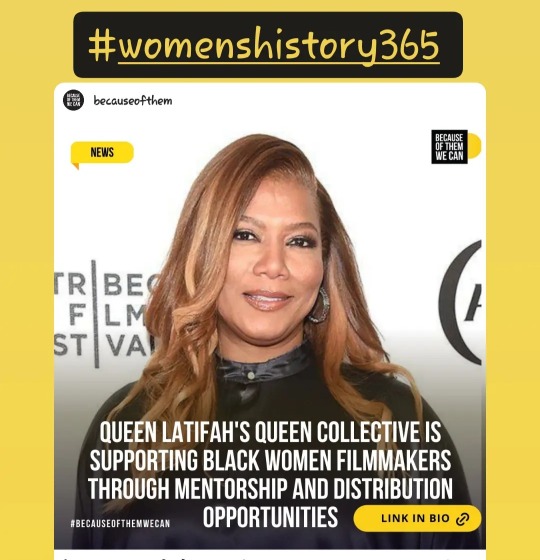
#Repost @becauseofthem
——
The Oscar-nominated actress continues to open doors for the next generation of Black creatives with the Queen Collective!
Click the #linkinbio to read more.
#becauseofthemwecan
0 notes
Text
Parks in Gilbert AZ

Gilbert is a fast-growing city in the Phoenix metro area and has positioned itself for growth by developing a highly diverse economy. It has become a place where families can find quality education, excellent healthcare and high-tech jobs.
It is home to a large number of parks that have plenty of activities for the entire family, from nature walks to horseback rides and bike trails. The town is also well-known for its Western heritage celebrations, such as Gilbert Days, a weeklong series of events celebrating cowboy culture.
This year, the event begins with a Pony Express ride from a local post office, bringing people to neighboring towns for a variety of fun activities including barrel racing and a rodeo. It also features a variety of food vendors, live entertainment and a Saturday festival.
Discovery District Park is a lovely place for a picnic or just a stroll in the park, with a lake that provides the perfect backdrop to sit back and enjoy the sights of nature. It has a playground, walking paths, and lots of benches for relaxing. The park also has a community fishing program, where residents can catch fish for free from two ponds.
The Riparian Preserve at Water Ranch is a beautiful spot for hiking, bird watching and fishing. It is located at East Guadalupe Road and features several ponds that are home to fish, birds, reptiles, and other local wildlife.
Freestone District Park is one of the most cleverly built parks in Gilbert, and it has attractions that are sure to please every member of your family. It has a miniature Ferris wheel, antique carousel, and train.
Another great attraction in the Freestone District Park is the water play area, which includes a pool, water slide, and a splash pad for kids. It's a fun place to spend a day with your kids, and it's completely free.
If you're a pet owner, the Cosmo Dog Park is a great place to spend some time with your furry friends. They have a huge off-leash play area, plus a small fenced in area for your pup to run and socialize with other dogs.
The Gilbert Historical Museum is a wonderful place to learn about the history of this amazing town. Its 9 exhibit rooms include a 100-year-old classroom, a military exhibit and plenty of artifacts to help you discover the rich and fascinating history of this quaint city.
Downtown Gilbert is a charming place to walk around and explore, with a variety of shops and restaurants that are sure to delight. It is also a great place to visit during the holiday season, when it comes alive with festive lights and music.
XII West Brewing of Gilbert is a new brewery that offers mouthwatering craft beers and drafts. They brew their beers in a garage, and they also have a flea market-style communal space that is ideal for beer tasting.
There are many great places to eat in Gilbert, from pizza to Mexican cuisine. But if you're looking for something special, we recommend checking out Vero Chicago Pizzeria (formerly Buddyz A Chicago Pizzeria) or Backyard Taco.

Plumbing Emergency Service
A leaking pipe, burst water heater, or broken toilet may not seem like an emergency, but they can cause significant damage to your home. A professional plumber can stop the leak, fix the pipe, and prevent further damage to your property.
Plumbing emergencies can include a range of problems, from flooding to sewer backups. A sewer backup is one of the most common and dangerous plumbing issues, so it’s important to call for an emergency plumber if you notice that your home is experiencing a backup.
Some plumbing emergencies can wait until business hours, but others need immediate attention to avoid causing further damage. For example, a toilet that backs up or won’t flush properly is a common problem.
Emergency plumbing service offer services for a wide range of needs, including toilets, sinks, bathtubs, and water heaters. They can also install and repair septic systems and sump pumps.
Costs for Emergency Plumbing
Emergency plumbers charge more than standard plumbing services because they’re needed at a moment’s notice. Their rates vary depending on the severity of the situation, but you can expect to pay around $50 to $125 per hour for an emergency plumber.
A highly professional plumbing company will always charge a fair rate for its services. They won’t be able to offer prices that are too good to be true because they’ve been in the business for a long time and know the value of their work. They’ll also be able to deliver results that you can be confident in.
James Plumbing
1777 S Oak St Gilbert, AZ 85233
480-716-0109
https://jamesplumbinggilbert.com
0 notes
Text
HER CARDBOARD LOVER
1926

Her Cardboard Lover is a three-act play by Valerie Wyngate and P.G. Wodehouse, adapted from the French play Dans sa candeur naïve by Jacques Deval. It was originally produced by Charles Frohman Inc. and A.H. Woods. It was staged by Gilbert Miller.
The Story: To make her handsome and popular lover Tony jealous, Simone enlists Andre to pretend to be her new love interest. She doesn’t count on the complications brought on by her doting cardboard lover.
The French play opened in Paris on January 13, 1926. The English translation premiered on Long Island NY on September 23, 1926, then on to Stamford CT on the 24th and 25th.

It arrived at at Nixon’s Apollo Theatre in Atlantic City on September 27, 1926 starring Laurette Taylor as Simone and Leslie Howard as Andre. Plans were for an October 7th arrival on the Great White Way. But instead, October 4th found the troupe in Washington DC. Then a full week in Baltimore MD.

A funny thing happened on the way to the Rialto.

The show was shut down after Baltimore, before Broadway, giving the opportunity to makes some changes to the script.

Brady wanted to recast Taylor to suit the revised script, but the star had a ‘run of play’ contract and there was an impasse about her withdrawal.

The matter was then referred to Equity and a lawsuit was initiated.

With Taylor out, who would play Simone?

Brady considered Katherine Cornell. Cornell considered it, but eventually passed on the project.

Brady finally settled on Jeanne Eagels, who gave up her role in a little play named Chicago to take the role.

In advance of its Broadway premiere, the new script tried out in Newark NJ where a critic noticed that the relationship between the characters had changed since Atlantic City.

The leading character was previously described as a mistress, but now called a divorcee.

The play finally opened on Broadway at the Empire Theatre (1430 Broadway) on March 21, 1927 where it ran for 152 performances.

A 1928 London tour of the play starred Tallulah Bankhead, with Leslie Howard reprising the role, running for 173 performances. Five minutes of the play was released in UK cinemas as a silent short. After the West End, she toured the play in the UK for much of 1929.

In 1941, the play enjoyed a US tour of regional theatres starring Bankhead reprising her role. One of the theatres was located in Maplewood NJ. It also played Ogunquit ME, White Plains NY, and other summer stock venues.

As soon as the play closed in New York City, Marion Davies bought the screen rights for herself. The silent film adaptation played in Atlantic City at the Capitol Theatre on Atlantic Avenue in September 1928. The title had been slightly changed to THE Cardboard Lover.

A second film version (totally rewritten) opened in Atlantic City at the Strand Theatre on Valentine’s Day 1932. The title was much more different, choosing instead The Passionate Plumber. It starred Polly Moran and Jimmy Durante. The film was also released in French, perhaps as a tribute to the play’s Parisian origins.

The final film version returned to its original title: Her Cardboard Lover. It opened at the Apollo Theatre in June 1942, the same theatre that had hosted the play starring Laurette Taylor in 1926. Considered a bomb, it was the final film of Norma Shearer.
#Her Cardboard Lover#The Cardboard Lover#Cardboard Lover#Atlantic City#Empire Theatre#Nixon's Apollo Theatre#Laurette Taylor#Jeanne Eagels#Katherine Cornell#Norma Shearer#Buster Keaton#Marion Davies#Tallulah Bankhead#Jacques Duval#Broadway#Broadway Play#1926
2 notes
·
View notes
Text
JACK BENNY
February 14, 1894

Jack Benny was born Benjamin Kublesky in Chicago, Illinois, on Valentine’s Day 1894. He had a successful vaudeville career, and an even greater career on radio with “The Jack Benny Program” which also became a successful television show. Benny was a Beverly Hills neighbor of Lucille Ball’s and the two were off-screen friends.

His screen persona was known for being a penny-pincher and for (badly) playing the violin. His theme song was "Love in Bloom" by Ralph Rainger and Leo Robin. He often used the phrase, "Now cut that out!"

Benny and Ball were first on the same bill in “Stars in the Eye”, a special marking the opening of Television City and including all the CBS stars. Lucy and Benny did not share any screen time.
On “Sunday Showcase: A Tribute to Eleanor Roosevelt on Her Diamond Jubilee” on October 11, 1959, Jack Benny, Lucille Ball and dozens of other stars turn out to pay homage to former first lady and humanitarian Eleanor Roosevelt. Arthur Godfrey hosted on NBC.
On June 24, 1962, Benny and Ball were on hand to quickly wish Ed Sullivan a happy 14th anniversary on “The Ed Sullivan Show” (S14;E41). Lucille Ball enters riding atop an elephant!
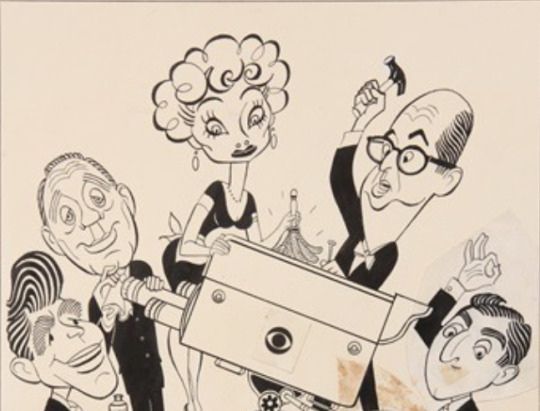
Another collaboration of the network headlines came in 1962 and 1963, when both “The Lucy Show” and “The Jack Benny Program” were on the CBS schedules. They launched the season with “Opening Night” TV specials.
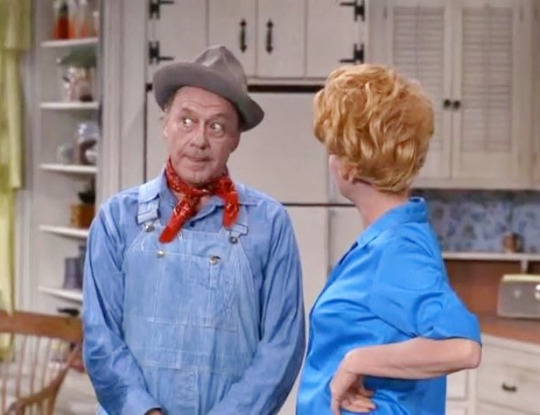
Benny appeared on “The Lucy Show” as Harry Tuttle (a Jack Benny doppelganger) in “Lucy and the Plumber” (TLS S3;E2), on September 28, 1964.
On October 16, 1964, Benny and Ball played themselves in "Chrysler Presents a Bob Hope Comedy Special: Have Girls - Will Travel." The show was used by RCA to sell color televisions.
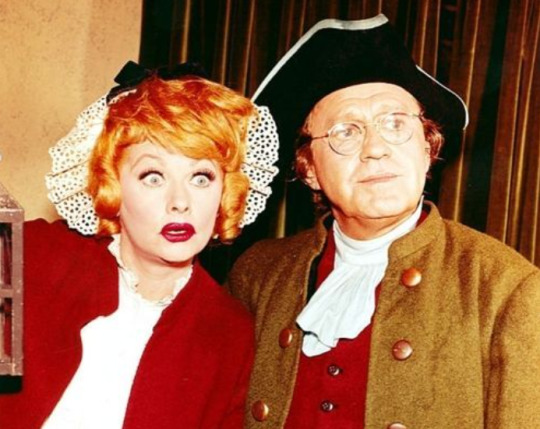
In return, Lucille appeared on “The Jack Benny Program” playing Mrs. Paul Revere, the woman behind the man. It aired on October 2, 1964.
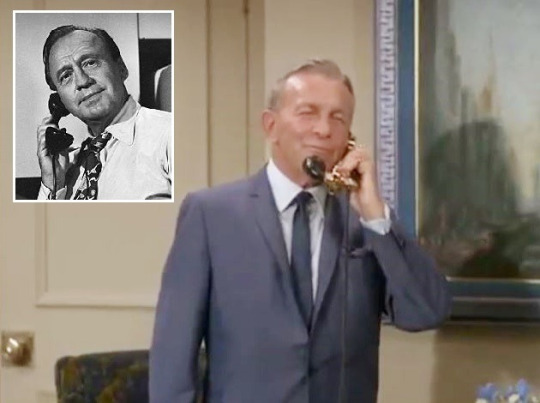
He did a voice over cameo as himself in “Lucy With George Burns” (TLS S5;E1), first aired on September 12, 1966.

The feature film A Guide For The Married Man (1967) had plenty of comic performers on the marquee, including Benny and Ball.
That same year, Benny and Ball provided voice over for a documentary by the United Jewish Welfare Fund titled All About People.
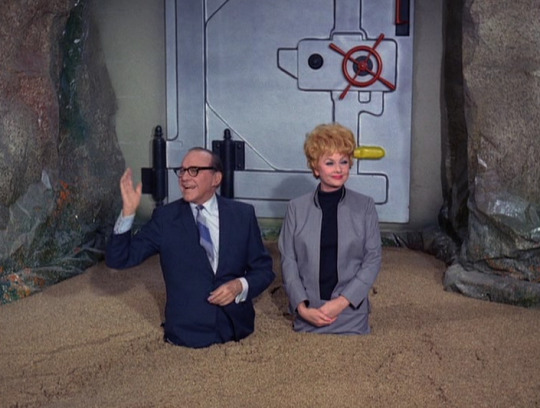
He played himself in “Lucy Gets Jack Benny’s Account” (TLS S6;E6), a stunt-filled episode that first aired on October 16, 1967.

On March 20, 1968, Lucille Ball appeared on “Jack Benny’s Carnival Nights” along with Johnny Carson and Ben Blue. Lucille played an exotic side-show attraction Luscious Lucille, a Woman on a Pier in a silent movie, and Agnes Kubelsky, Benny’s mother!
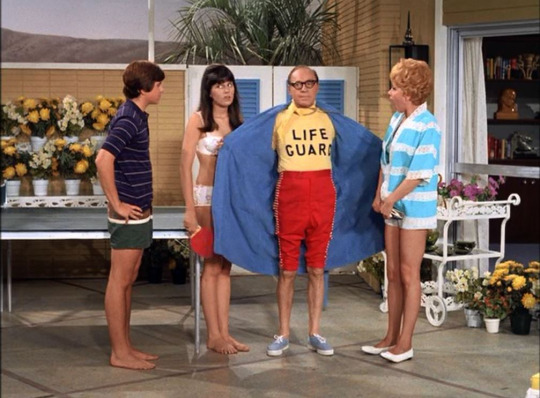
He played himself on “Here’s Lucy” three times, starting with the second episode, “Lucy Visits Jack Benny” (HL S1;E2) on September 30, 1968. The action was set at Benny’s Palm Springs home, which he was renting out as a resort!

Ball and Andy Griffith were the main guest stars on “The Tennessee Ernie Ford Special” on November 16, 1968. Benny made a quick pitch for his special “Jack Benny’s Bag” which followed, but did not feature Lucille Ball.
On December 19, 1968, Ball and Benny joined other stars on “The Dean Martin Christmas Special” in cameo announcements about toys being sent to children’s hospitals. Each cameo was self-contained.

On “Jack Benny’s Birthday Special” on February 17, 1969 (3 days after his 75th birthday) Lucille Ball appeared and did patter with Benny as well as played Lucille LaTour in an old West sketch.

As “Jack Benny’s New Look” is nearly over, Lucille Ball walks by and says “How dare you do a show without me?” slaps Benny and exits! This walk-on cameo happened on December 3, 1969.

“Lucy and Jack Benny’s Biography” (HL S3;E11) on November 23, 1970, Benny dictates his memoirs to secretary Lucy, and the episodes come to life for viewers, with Lucy playing all the women in his life, including his wife Mary Livingstone, although Lucille Ball lip synchs to Livingstone’s actual voice!

“Jack Benny’s 20th Anniversary Special” on November 16, 1970, featured Lucille Ball playing the Benny’s maid Janet in a scene with Benny’s real-life wife Mary Livingstone. Ball receives no screen credit but gets a verbal thank you from Benny at show’s conclusion. Lucy has three lines and 30 seconds of screen time!
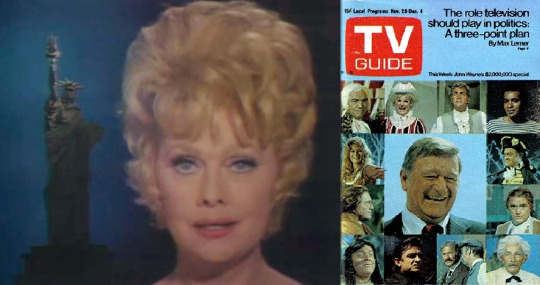
Lucy, Benny, Bob Hope, Dean Martin, George Burns, and Red Skelton, all appeared in the patriotic TV special “John Wayne’s: Swing Out, Sweet Land” which aired on November 29, 1970.

Benny has a walk-on cameo at the end of “The Unemployment Follies” (HL S3;E22) on February 8, 1971 starring Carol Burnett, his second appearance on “Here’s Lucy”.
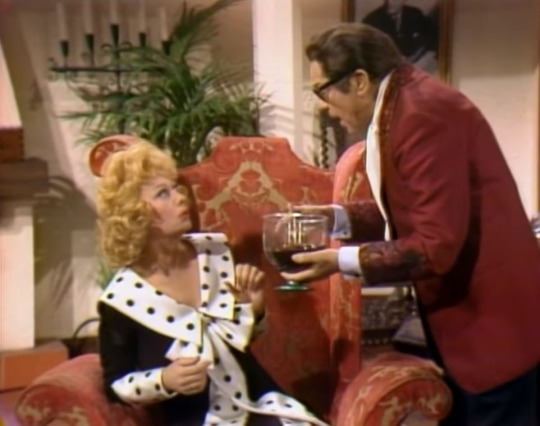
In “Everything You Always Wanted to Know About Jack Benny But Were Afraid to Ask” (March 10, 1971), Lucy plays a chorus girl seduced by movie star Benny.
“The 23rd Annual Primetime Emmy Awards” on May 9, 1971 featured Benny and Ball (who presented an award).
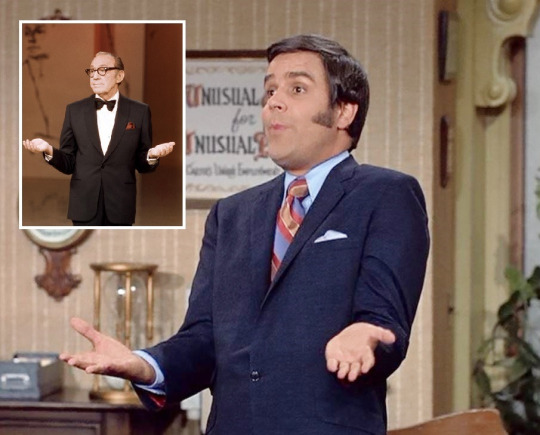
His final appearance on “The Lucy Show” was in “Lucy and The Celebrities” (HL S4;E10), on November 15, 1971, had Benny playing himself and imitated by guest star Rich Little!
The Friars Club celebrates Milton Berle’s 60 years in show business on December 4, 1973. Sammy Davis Jr. hosts with guests Lucille Ball, Jack Benny, Jackie Gleason, Bob Hope, and others.

The last public appearance of Jack Benny was roasting Lucille Ball on “The Dean Martin Celebrity Roast for Lucille Ball” aired on February 7, 1975. Benny died weeks after the taping of this special. Dean Martin appeared in a special introduction dedicating the show to Benny’s memory.
“Age is strictly a case of mind over matter. If you don't mind, it doesn't matter.” ~ Jack Benny
Jack Benny succumbed to pancreatic cancer on December 26, 1974 at age 80 although he never admitted to being older than 39. He was survived by his wife Mary Livingstone, with whom he adopted a child, Joan.
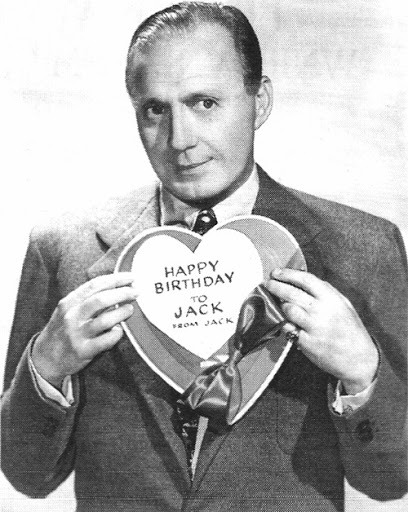
2 notes
·
View notes
Text
Best Plumbing Company in West Chicago
West Chicago Plumbing Services Company

We are the plumbing company of choice when you need a West Chicago Plumber!
From jobs as big as a full remodel to jobs as small as a leaky faucet we will be there for you!
We are open for emergency plumbing. Contact us today for any plumbing issues!
#West Chicago Plumbers#Plumbing Services in West Chicago#Plumbing Solutions#PBG Plumbing#Best Plumbing Services
8 notes
·
View notes
Text
Plumber West Chicago

Are you looking for a plumber West Chicago area? Call for PBG Plumbing team’s experts for pipe repair, tankless water heater installation, new construction, and maintenance needs.https://pbgplumbing.com
8 notes
·
View notes
Text
There never was a more holy age than ours, and never a less. Annie Dillard.
"No, really," the man at the bar says with second-hand pride. He gestures to the younger man beside him, who ducks his head, smiles. I have been quietly nursing the same beer for half an hour, listening to them talk to one another. They only occasionally remember that they have an audience, even more rarely that it's me. "He's a photographer, an artist. The kind that doesn't have a day job."
It's a Thursday night and the median age in the bar is somewhere in the late forties. The photographer and I make up the entire lower half of the bell-curve.
"Must be nice," interjects a third voice, from further down the bar. He's been largely quiet, his face turned away so he can watch the Phillies lose. "I'd like to be an artist."
The first man, the older man, laughs. "C'mon, we'd all like to be artists," he says with perfect sureness, as though this is a fact, immutable as gravity or the rising of the sun.
He works for the state, he told me; Department of Transportation. He works on "the turnpike." (I have only been in Philadelphia a week and a half, I don't know what he means, but I nod like I understand.) He gets good benefits, that's the thing. Otherwise he'd be an artist.
"What sort of artist?" I ask, an inconvenient reminder that I am still here, listening. Luckily, they seem to forget it again quickly; they're too busy arguing whether carpentry counts as art, and then the bartender asks if travel writing is art or journalism, is journalism an art? What is art, anyway?
I get their professions in bits and pieces: construction, plumber. An unlikely accountant, given the number of tattoos. A bartender, a host at a chain restaurant. An almost-attorney, not even through her second week.
In the end, we all agree: we would rather be artists.
.
It's instructive, moving to Philadelphia when all that waits for you there is an empty apartment and a borrowed air mattress. The bare walls force you out into the world, or at least to the nearest coffee shop with an internet connection. You spend a lot of time nursing lukewarm lattes, and googling "philly events + this weekend."
I don't remember how I found out about the Wagner Free Institute of Science. (There were a lot of recursively nested links, I clicked on all of them.) The museum itself was too far for a jaunt after work, but they were offering a free six-week class at a nearby library branch. The history of cartography: how maps evolved from second- or third-hand accounts of sundials to the real-time GPS math-sphere we know today.
It's been a few years since my last history of science class, but I have fond memories of wide-ranging, bitter arguments. The scientific method seems immutable until you realize that it was invented before modern mathematics, and produced reliable results that are laughable within the modern paradigm. An atom looks like a circle and x-y graphs are perfectly readable until you stop and consider that alchemists considered their dense, symbolic depictions legible too. The human knowledge-making endeavor is always specific to a time and place, and they shape one another.
(I love law's pragmatism, but there will always be a part of me longing for a two-hour argument about epistemology and whether we can ever really know anything.)
I decided to attend the class, thinking that it would be entertaining even if it was just me and the professor in a library conference room.
When I first walked into the conference room, I thought for a minute maybe I'd gone to the wrong library branch. There were too many people: some fifty-odd bodies, retirees and young professionals, a handful of college students. One young man in scrubs. Rows of uncomfortable metal chairs, and almost all of them were full. Shortly after I arrived, people had to be dispatched to go find more.
By the time the class started, people were leaning against the walls. I'm not sure who was more surprised, the professor or all of us.
It was one of the retirees who raised his hand first, as the professor talked about an Egyptian map of the underworld found on the bottom of a sarcophagus. "How do you know it's a map?" he asked. All I could see was his cheek, not-quite clean shaven. "How do we know it isn't art?"
Almost before he was finished speaking, three other hands went up.
By the end of the period, the professor had to gloss over Ptolemy in the last five minutes. There wasn't time for more, what with all the questions.
.
I am always a little startled when large numbers of people turn up to listen to opera.
There are a dizzying number of articles and thinkpieces about its imminent death. The pleas for donations get more and more feverish every year, even as the season is shrinking. All amid lamentations that it's a niche interest with a dwindling audience—opera is for old men and the pretentious, Harold Bloom et al. If you like singing there's musical theater and if you like drama there's the soaps; we as a culture have outgrown the need for valkyries, madwomen, and other assorted fat ladies singing.
Hence my surprise when, every year, Chicago's Lyric Opera fills Millennium Park to overflowing for their preview of the upcoming season. Families with children and dogs crowd up against retirees with bottles of wine and paper plates of fine cheese; everyone applauds. It's hard to imagine the death knell of opera on those nights, when couples bend their heads together and small children run through the crowd to the strains of "Mein lieber Hippolyte."
It's even harder to imagine when a broadcast—not even a live performance!—of "We Shall Not Be Moved" fills the mall of Independence National Historical Park.
Maybe it's the subject matter. A modern opera about racism and inequality, set in the shadows of the West Philadelphia MOVE bombings, is powerful and challenging content for an opera. "We Shall Not Be Moved" sold out during its initial run-through; in the shadow of Independence Hall, its questions about America's promise and the nature of the law took on a bitterly ironic quality. It's also a decidedly Philadelphia story, the rawness and relevancy only compounded when the National Park Supervisor introduced it by insisting her department has "a very good relationship with the Philadelphia police" alongside their commitment to supporting free speech.
Or maybe modern opera is more enticing—you have to love opera already to care about Lucia di Lammermor as the epitome of bel canto. You don't have to know anything to be intrigued by an opera about black children in Philadelphia. This is the artistic era we live in, Founding Fathers reference Biggie on Broadway, inner city kids perform chamber opera. For all I know, people turned up just to hear "girls want to get with it/North Philly slayer, player" sung in a sonorous bass-baritone.
But I think the truth is simpler: people still want to see opera, they've never stopped. They want to sit and listen to music, whisper to one another and watch. I was just behind a family of five: mother, father, and three boys, all at that age when they are mostly limbs and nervous energy. One—the oldest, a teenager, as evidenced by how hard he was trying to ignore the rest of his family—was defiantly trying to sleep, one arm thrown over his eyes. He moved only to shift to a new position, and once to pet a dog that wandered through the crowd.
An expensive ticket would have been wasted on him. But the event was free so he was there, sitting beside his brother and pretending, with all the bravura of adolescence, to be somewhere else. The light from the projector cast the rest of his family in silhouette: four faces, turned up to the screen. I wondered if all four of them would been there, if the tickets were sixty, ninety dollars each; if any of them would have come.
I'm distracted by a child, barely older than six, wandering through the audience. She stops suddenly, looking around and calling for her mother. The audience thrums like a plucked string to the sound, even in the half-dark you can see people's mouths shaping, lost, shaping, help. It only takes a few minutes for the child's brother to dart through the crowd and take her hand, whisk her away and back to their blanket. The audience settles again.
In a folding chair just a little ways away, an old woman is absently conducting, as though the musicians on screen could see her—one-two-one-two, just her hand for a baton.
#foul fetid fuming foggy filthy philadelphia#long post for ts#sarah's ongoing love letter to humanity#this is a thing I made
302 notes
·
View notes
Photo

Chicago friends: I will be at @madeinchicagomarket at Plumbers Hall in the west loop this Saturday! Stop by and get some locally made goods ✨ . . . . . . . . . . . #folktaleweek #characterdesign #cutecreature #magicillustration #illustration #artbasel #illustree #illustrateddoris #art #drawing #procreateapp #ipadproart #pandawebarebears #childrenswritersguild #scbwi #moreillustrations #illustration_best #artguide_illustration #cutedrawing #aquarelle #watercolor #cuteart #happyart #best_of_illustrations (at Chicago, Illinois) https://www.instagram.com/p/B5VeaoijjyP/?igshid=rul3m6lv503
#folktaleweek#characterdesign#cutecreature#magicillustration#illustration#artbasel#illustree#illustrateddoris#art#drawing#procreateapp#ipadproart#pandawebarebears#childrenswritersguild#scbwi#moreillustrations#illustration_best#artguide_illustration#cutedrawing#aquarelle#watercolor#cuteart#happyart#best_of_illustrations
1 note
·
View note
Text

All set up @chicagozinefest today May 18 from 11am-6pm at Plumbers Union Hall (1340 W Washington Blvd) in the West Loop. Check it out! #czf2019 #chicagozinefest #chicago #zines #comics
5 notes
·
View notes
Text
Race for Chicago mayor 2023 – Chicago Tribune
Race for Chicago mayor 2023 – Chicago Tribune
2022-09-09 13:07:56
Chicago Mayor Lori Lightfoot greets the crowd as she enters the room during a petition launch party for her reelection at Plumbers Local 130 in the West Loop on Aug. 30, 2022. (Chris Sweda / Chicago Tribune)
Major candidates for Chicago mayor 2023
Recommended Photo Galleries
http://www.chicagotribune.com Source link
Andrew Johnston

View On WordPress
0 notes
Text
The Signs as Musicals:
Aries: West Side Story - (1975) The musical explores the rivalry between the Jets and the Sharks, two teenage street gangs of different ethnic backgrounds. The members of the Sharks, from Puerto Rico, are taunted by the Jets, a white gang. The young protagonist, Tony, a former member of the Jets and best friend of the gang's leader, Riff, falls in love with Maria, the sister of Bernardo, the leader of the Sharks.
Taurus: On The Town - (1944) t’s 1944, and a trio of sailors arrives in New York City for 24 hours of shore leave, eager to see the sights and meet pretty girls. On the subway, Gabey spots a poster of “Miss Turnstiles,” Ivy Smith, and instantly becomes obsessed with meeting her. Elsewhere, Chip takes a ride with an outgoing cab driver named Hildy, and Ozzie meets anthropologist Claire de Loone at the Museum of Natural History. By the next morning, the guys and their gals have enjoyed a night of dance and romance in some of the city’s hottest nightclubs, an adventure none of them will ever forget.
Gemini: Heathers: The Musical - (2010) Heathers is a rock musical based on the 1988 cult film Heathers. is the story of Veronica Sawyer, a brainy, beautiful teenage misfit who hustles her way into the most powerful and ruthless clique at Westerburg High: the Heathers. But before she can get comfortable atop the high school food chain, Veronica falls in love with the dangerously sexy new kid J.D. When Queen Bitch Heather Chandler kicks her out of the group, Veronica decides to bite the bullet and kiss Heather’s aerobicized ass…but J.D. has another plan for that bullet. The show, while a comedy, is a sexually charged high school drama that deals with issues of teen suicide, murder, bullying, homophobia, and gun violence.
Cancer: Evita - (1978) Evita is based on the historical story of María Eva Duarte de Perón, a poor Argentinian girl who grows up to be the wife of the president of Argentina, worshipped by her people. As a young woman who longs for an acting career, fame, and fortune, Eva quickly learns that her feminine wiles hold power among a culture, and a political system, run by men. Once she makes it to Buenos Aires, Evita finds fame and power in her powers of seduction, eventually seducing the rising political figure, Juan Perón, who becomes the President of Argentina. As First Lady of Argentina, she aligns herself with the poor, winning herself, and Perón, popularity among Argentinians. Evita becomes a hero to the poor and the working class—and an enemy to the rich. A young and unknown revolutionary, Ché, narrates the rise and fall of the beloved matriarch of the Argentinian people.
Leo: A Chorus Line - (1975) Centered on seventeen Broadway Dancers auditioning for spots on a chorus line, the musical is set on the bare stage of a Broadway theatre during an audition for a musical. A Chorus Line provides a glimpse into the personalities of the performers and the choreographer as they describe the events that have shaped their lives and their decisions to become dancers.
Virgo: Cats - (1981) The musical tells the story of a tribe of cats called the Jellicles and the night they make what is known as "the Jellicle choice" and decide which cat will ascend to the Heaviside Layer and come back to a new life.
Libra: Rent - (1993) Rent follows the ups and downs of a year in the life of a group of impoverished, artistic friends living in Manhattan’s East Village. Mark, an aspiring filmmaker, struggles to find his place in the world; his roommate Roger, an HIV-positive musician, wonders how he will leave his mark before he dies. Mimi and Angel look for true love as they face the harsh reality of life as HIV-positive young people, while the businesslike Joanne seeks fidelity from her wild-child performance artist girlfriend Maureen. The group’s dreams, losses, and love stories weave through the musical’s narration to paint a stunningly raw and emotional portrait of the gritty bohemian world of New York City in the late 1980s, under the shadow of HIV/AIDS.
Scorpio: Chicago - (1975) Set in the legendary city during the roaring “jazz hot” 20s, Chicago tells the story of two rival vaudevillian murderesses locked up in Cook County Jail. Nightclub star Velma’s serving time for killing her husband and sister after finding the two in bed together. Driven chorus girl Roxie’s been tossed in the joint for bumping off the lover she’s been cheating on her husband with. Not one to rest on her laurels, Velma enlists the help of prison matron Mama Morton and slickster lawyer Billy Flynn, who turn Velma’s incarceration into a murder-of-the-week media frenzy, thus preparing the world for a splashy showbiz comeback. But Roxie’s got some of her own tricks up her sleeve… The story is a satire on corruption in the administration of criminal justice and the concept of the "celebrity criminal”.
Sagittarius: Newsies - (1992) Based on the real-life Newsboy Strike of 1899, this new Disney musical tells the story of Jack Kelly, a rebellious newsboy who dreams of a life away from the big city. After publishing giant Joseph Pulitzer raises newspaper prices at the newsboys’ expense, Kelly and his fellow newsies take action. With help from the beautiful female reporter Katherine Plumber, all of New York City soon recognizes the power of “the little man.”
Capricorn: Kinky Boots - (2012) Based on the 2005 British film Kinky Boots, the musical tells the story of Charlie Price. Having inherited a shoe factory from his father, Charlie forms an unlikely partnership with cabaret performer and drag queen Lola to produce a line of hugh-heeled boots and save the business. In the process, Charlie and Lola discover that they are not so different after all.
Aquarius: Hair - (1967) A product of the hippie counterculture and sexual revolution of the late 1960s, several of its songs became anthems of the anti-Vietnam War peace movement. The musical's profanity, its depiction of the use of illegal drugs, its treatment of sexuality, its irreverence for the American flag, and its nude scene caused much comment and controversy.
Pisces: Legally Blonde - (2007) The story is based on the novel Legally Blonde by Amanda Brown and the 2001 film of the same name. It tells the story of Elle Woods, a sorority girl who enrolls at Harvard Law School to win back her ex-boyfriend Warner. She discovers how her knowledge of the law can help others, and successfully defends exercise queen Brooke Wyndham in a murder trial. Throughout the show, no one has faith in Elle Woods, but she manages to surprise them when she defies expectations while staying true to herself.
#aries#taurus#gemini#cancer#leo#virgo#libra#scorpio#capricorn#aquarius#pisces#sagittarius#horoscope post#horoscopes#horoscope#zodiac#zodiology#star signs#astrology#broadway#music#musical#musicals#broadway musical#the signs as
378 notes
·
View notes
Text
Female Musical Characters I’d Willingly Let Murder Me (Long Post)
Heather Chandler - Heathers

Roxie Hart - Chicago

Velma Kelly - Chicago

Christine Daaé - Phantom of the Opera
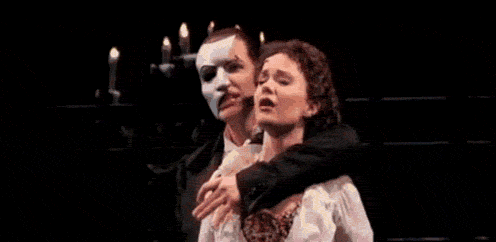
Wednesday Addams - The Addams Family

Katherine Plumber/Pulitzer - Newsies

Joanne Jefferson - RENT

Angel Dumott Schunard - RENT

Fiona - Shrek

Bea Bottom - Something Rotten
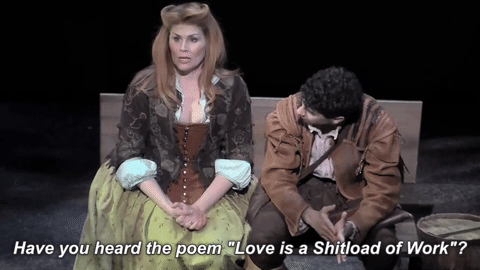
Any of the Schuyler Sisters - Hamilton

Elle Woods - Legally Blonde

Anita - West Side Story

Janice Ian - Mean Girls

Satine - Moulin Rouge

Hedwig - Hedwig and the Angry Inch

Yitzhak as Crystal - Hedwig and the Angry Inch

#i may make one of these for the male characters later on#and then one for the nonbinary or otherwise gender queer/fluid or the ones whos gender isnt introduced#i may end up adding more to this later#if i remember some that ive forgotten#when i try to think of things my mind goes blank#edit: look at me literally a minute later adding on mother fucking satine#the one who started this whole thing#and yet i forget to put her#and hedwig
1 note
·
View note